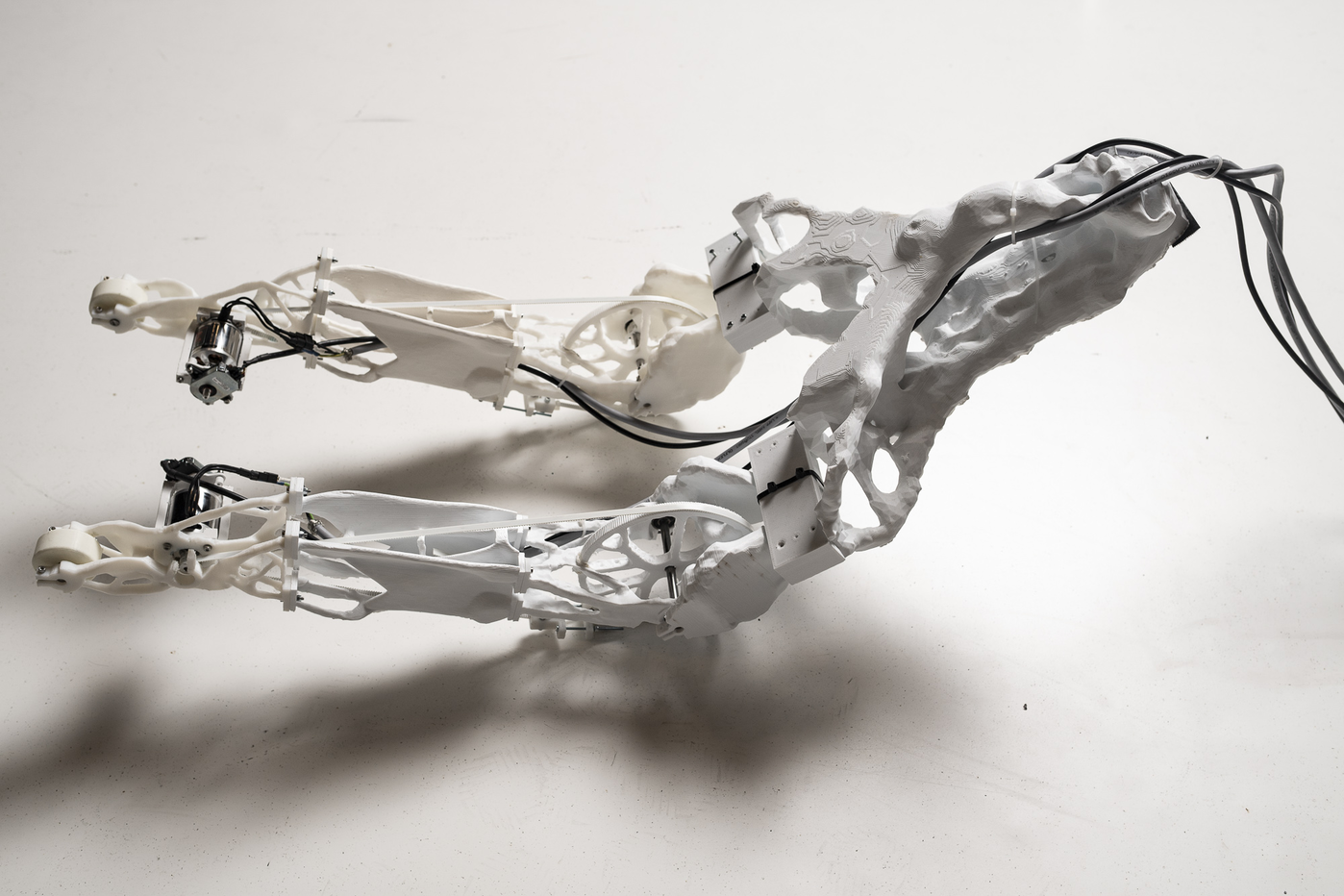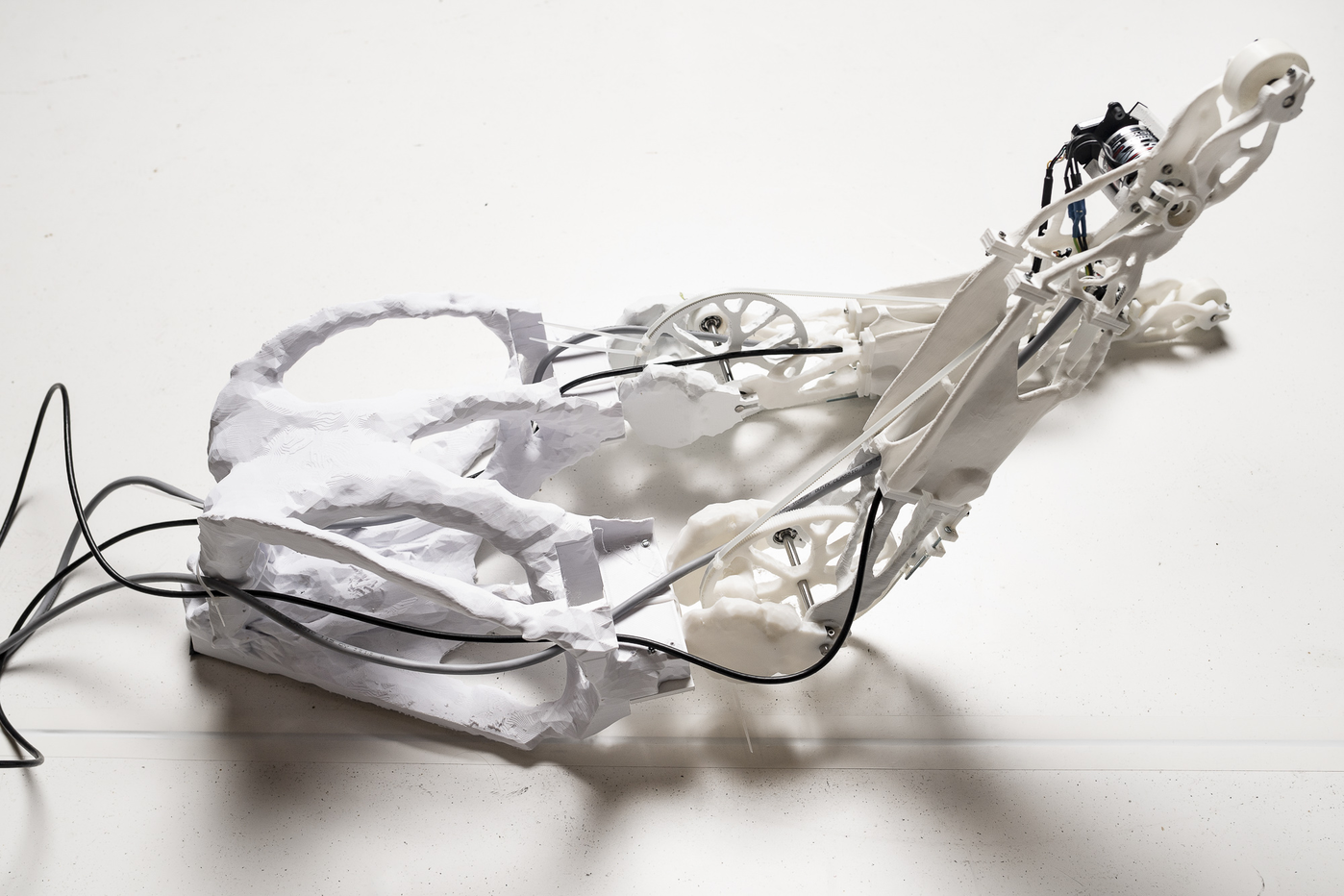Figure #11 and 12: Bones
Figure 11 and 12 were created for the composition Nether and developed over several months. Most of the figure's body is 3D printed in an off-white filament that gives the material a bonelike quality. There is a main trunk or body that is somewhat reminiscent of a human ribcage or pelvis to which two protrusions that can be construed as "legs" or "arms" are attached. Each of these legs consists of four sections. The backmost (attached to the trunk) having as part of its structure a wheel with GT2 teeth. In this section, two ball bearings and an eight-millimetre axle allow the leg to rotate 180 degrees. The axle is mounted at two points giving the mechanism a tight sideways tolerance.
The next part of the leg provides length and widens a bit to withstand lateral forces. It leads to the final section, which holds a stepper motor (later changed to a brushless motor for both figure #11 and#12) attached to the inside of the "leg." This motor has a small pulley attached to its shaft that pulls on a white GT2 timing belt that extends from the pulley around the wheel of the back part of the leg. Two adjustable belt fasteners hold it taught. It will pull itself along the belt when the motor rotates, causing the leg to bend at the axle mounted in the back part. The wheel at the back is 15 cm across and the pulley 1 cm giving a 15:1 reduction ratio helping to increase motor torque.
This figure is, for a large part, designed with the aid of generative design. The leg's front and midsections are "grown" using generative design, and the structures connecting the contact points, the trunk, and other leg sections created using topology optimization. It gives the figure quite an organic look, and since it is 3D printed using white filament, most people who have seen it describe it as bonelike.
At the end of each leg, there are two small wheels 3d printed in a flexible material1. These rotate around an eight-millimetre axle using one-way needle pin bearings, allowing the wheel to turn freely in only one direction.
Both figures are intended to lie on the ground. If both the "legs" bend at the same time towards the floor, the figure will lift itself into an upside-down V, and because the wheels can only rotate one way, it will also pull its "backside" forward. When it stretches out its legs again, the wheels will roll forward so that the figure will have moved forward 20 – 30 cm. If both "legs" bend the other way, the balance is such that the back part of the figure rises while the legs remain on the ground. If only one leg is bent upwards, it rises into the air, and lastly, if one leg is bent downward further than the other, the whole figure tilts to one side.
The figure can drag itself forward. It is also possible to turn the figure by using a more complex sequence of movements involving tilting it up on its side and rotating around the point in contact with the floor.
The electronics driving the figure are housed in an organically shaped blob of plastic dragged behind the figure from two wires connected to the motors.
Impetus
Figures #11 and #12 was an investigation into the creation of a mobile figure that incorporates shapes that emerge not only from the encounter between my conception and the affordances of the tools and materials used to create them, but rather finds materiality that is foreign to that encounter through outsourcing parts of the design process to genetic computer algorithms. By using generative design, figures #11 and #12 developed their limbs to achieve what I consider organic-looking structures. Outside of the mechanical advantage of generative design providing superior strength to weight ratio, I immediately recognize a bonelike quality in the figure's body.
Figures #11 and #12 continue the investigation of mobility as means for causing affect and potential for recognizing intent in the activity of the figures. Similar to figures #9 and #10, their motion, particularly forward, seems to be characterized by struggle. It is slow and laborious. To me, this triggers empathy towards the figures as I sympathize with the strenuous effort they make to propel themselves.
I find that figures #11 and #12 also have some commonalities to figure #7 and #8 – fingers in that I recognize their shape and materiality as being reminiscent of something specific(they make me think of the bone in a human pelvis or ribcage as it might be with no flesh). However, in this case, the object the figures are reminiscent of belongs as part of a larger structure familiar to me(the human body). If they are taken to be what I recognize they are somehow dislocated and in “the wrong place”. They must be incomplete since the rest of the human body is missing and they are fleshless. If they in fact were what I recognize in them, they would not be moving. The fact that they are moving and seem to be content and complete as they are creates an interesting discrepancy between what I am reminded of and what they are. Where figures #7 and #8 can on some level be taken to be like an animal, for example a dog, figures #11 and #12 can only ever be considered part of one, and their physical movements is contrary to such an interpretation.







